
Air Force officials install a new artificial reef on the shores of Tyndall Air Force Base, Fla., on Oct. 30, 2024. A Rutgers University team of oyster researchers is working with the Defense Advanced Research Projects Agency on the reef, which is designed to protect the base from hurricanes and flooding. (David Bushek/Rutgers University)
A Pentagon agency that pioneered such technologies as four-legged robots is now giving rise to reefs made with coral and oyster colonies that it hopes will soon protect coastal military bases from deadly storm surges.
The first section of an experimental reef made with concrete modules and living oysters was installed last week on the shore of Tyndall Air Force Base in northwestern Florida, according to Rutgers University.
The New Jersey university’s team of oyster researchers is working with the Defense Advanced Research Projects Agency, also known as DARPA, and a team of international scientists on the reef, which is designed to shield the base from the effects of hurricanes and flooding.
Meanwhile, the waters of the Pacific Ocean are in line to see shortly the handiwork of another DARPA team in the endeavor, known as “Reefense.”
The University of Hawaii is building two concrete reef prototypes, the first of which will be anchored to the seabed near the Ulupaʻu crater, off the Kailua Bay side of Marine Corps Base Hawaii in late 2024 or early 2025, the university said in September.
A third team in the Reefense program is led by researchers at the University of Miami.
Reefense is funded by a $19.4 million DARPA grant. The program seeks to find out whether the reef-mimicking structures can mitigate the flooding, erosion and storm damage that increasingly threaten infrastructure and personnel, according to the agency.
Of the three Reefense locations, Florida’s Gulf Coast is the only one using the hybrid artificial-living oyster barriers. The other two are going to cultivate colonies of coral.
On Wednesday, a crane lowered a segment of the reef into shallow water about 200 feet off the shoreline in St. Andrew Bay in the Florida Panhandle, the university said in a statement last week.
The structure will ultimately be 160 feet wide, composed of about 800 interconnected concrete cubes created by Rutgers scientists in collaboration with researchers from several institutions, the statement said.
The structures feature large holes to dissipate wave energy and are specifically designed to attract oysters, university officials said.
The purpose of the holes is to absorb and dissipate wave energy, protecting the shore beneath and the shallow area closer to the shoreline, while also forcing larger waves to break farther out, the university said.
The hope is that more oysters, which can form natural seawalls in shallow water, will attach to and colonize the honeycombed barrier, ultimately forming resilient “living reefs,” Rutgers officials said.
In 2018, Hurricane Michael destroyed Tyndall’s hangars and caused more than $1 billion in damages to F-22 fighter jets that were left behind in the storm, according to the Air Force.
That toll could grow amid rising sea levels and beach erosion, scientists have said.
The word “hybrid” is used to characterize the reefs, which blend artificial and biological components.
“Artificial reefs are not new, and to some degree even hybrid reefs are not new,” Andrew Baker, a University of Miami professor and lead project researcher, told the Miami Herald last year. “What’s new about all of this is thinking about: How do we do this in the best possible way? What’s the best design to reduce wave energy?”